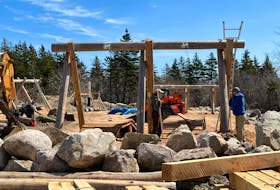TRURO, N.S. — Sounds of everyday life fade away as Keith Elliott focuses on his work.
It's serene. More serene than one might expect.
Elliott has spent much of the summer working on gravestones at Truro Cemetery, on Robie Street.
“I find it very peaceful,” he said. “I don’t hear the traffic or anything when I’m in here. I find cemeteries very calming.
“Sometimes I just put earbuds in and enjoy listening to something while I’m working.”
When Elliott is hired to do restoration work, he first has to determine which stones he can deal with. Some are in such bad shape they’re beyond hope.
“A lot fall into disrepair because no one remembers the people,” he said. “Once they’re beyond living memory they often become just a name on a stone.
“A lot of the old stones came to the area as ship ballast and some stone lasts a long time. Sandstone will last hundreds of years; limestone doesn’t last as well.”
Each stone tells a story. Many share the same story.
“Looking at them, you get a sense of how many died while quite young.
“Sometimes information on a stone is quite involved and will tell you the cause of death. Sometimes you see a lot of deaths in one year. You see a lot from 1919, when the Spanish flu hit.
“You can’t really tell how much money people had from the stones. Some people would spend every nickel they had on a stone, even when it caused hardship.”
When he sees a stone from someone born as long ago as 1700, he imagines what the area looked like at the time.
Because of the wet spring, he wasn’t able to begin work in Truro until July. He’s done repairs to about three dozen stones and has placed others, no longer upright, on sandstone slabs to keep them from sinking into the ground.
“Work has been ongoing over the years,” said Douglas Purdy, superintendent of the cemetery. “We want to preserve what we can. It’s history and it’s interesting to look at the stones. There are about 6,000 and I keep noticing new things.
“The Frannie stone is my favourite. It restored very nicely.”
The gravestone, for a 16-year-old girl who died Jan. 13, 1874, was lying on the ground with mud packed around the engraving earlier this year. Now it’s upright, every word legible.
“Frost is the biggest enemy here,” said Elliott. “It’s caused a lot of stones to tilt and fall. Some of the older stones have pins that expand and rust, and then break. Then you see a stone with the top broken off.”
Elliott also makes new gravestones. He engraves them himself.
He started with carving wood, then learned about bone carving from the Maori while travelling in New Zealand. He went on to train in drafting and engraving. He learned a lot about sandstone from his uncle, whose family has worked with the material for generations.
“I like them both but it’s very different working with wood and stone,” he said. “If you try to carve stone, like wood, you’ll ruin it.”
More of Elliott’s work can be found online at https://www.keithelliottstone.com/ or https://www.facebook.com/keithelliottstone/
The Truro Cemetery website is located at www.trurocemetery.ca


Cleaning gravestones
Keith Elliott recommends using a soft white bristle brush and plain water to clean gravestones. Household cleaners can cause staining and damage. Chlorine causes white stones to turn grey.
Some stones have been sandblasted, but that makes them more vulnerable to future damage.
Truro Cemetery
– The cemetery is located on the site where the first Presbyterian Meeting House was built in 1768.
– Includes the graves of a Nova Scotia Premier, Lt. Col. G. I. Smith; a Father of Confederation, Sir Adams G. Archibald; and 13 town mayors
– The oldest section is a designated municipal and provincial heritage site.
– The oldest gravestone is that of Jane Savage who died April 3, 1767, at the age of 24.
– Immaculate Conception and Zion Baptist churches each have their own burial sections at the cemetery.
– The cemetery is administered by a volunteer board of directors.
– Truro Cemetery Corporation is a registered charity.
– The archives has undertaken a project to document and photograph each gravestone. When completed, records will be available at the cemetery office and on the Colchester Historical Society’s website.








